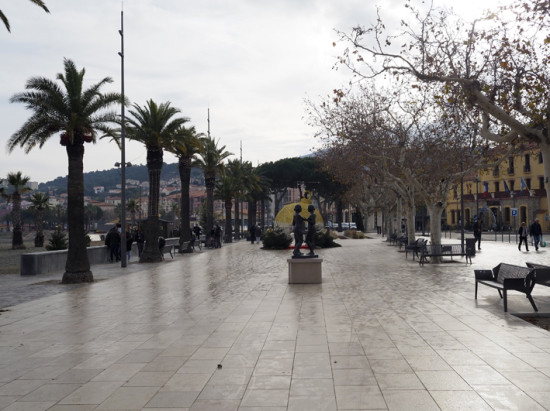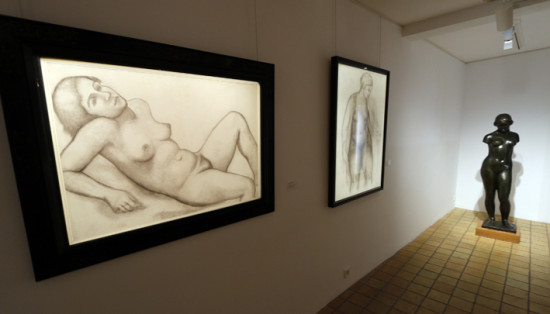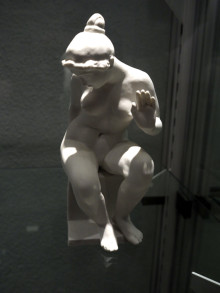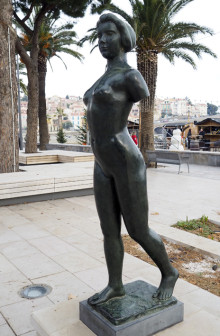Maillol in Banyuls
In 1861 Banyuls de la Marenda, in Roussillon, saw the birth of sculptor Aristide Maillol, one of the most representative of the 20th century, who at the age of twenty moved, like so many others, to Paris. When he returned to his native land, in 1910, he settled on a farm in the Roume Valley, on the outskirts of the town. Currently the house has become a museum dedicated to his work, where some designs, drawings and, of course, statues are exhibited.
Son of Raphaël Maillol and Catherine Rougé, he did his first drawing studies in the town and in Perpignan. In Paris he enrolled at the École Nationale des Beaux Arts, where he learned tapestry, drawing, lithography and painting. In fact, it is in tapestry that he started with a workshop, in which Clotilde Narcis worked, who would be his wife and his model. It was not until he was almost forty years old that he began to work as a sculptor, an activity that he would conduct until the end of his life. In 1902 he held his first exhibition where he showed thirty-three pieces that would be greatly received by the public. Some consider him the successor of Auguste Rodin, despite the obvious difference in styles, Maillol's already imbued with the modernism prevailing at the time. Maillol personally knew Rodin, whom he admired and of whom he said: “Rodin c’est un génie qui a donné le mouvement à tout son époque. (…) Rodin c’était un Dieu”. (“Rodin is a genius who gave movement to his entire era. (…) Rodin was a God.”)
Maillol's main theme is woman's body, because he considers her the origin of life, in the sculptures conceived her as the materialization of abstractions, feelings or places. The poet and essayist Claude Roy, in his work Maillol vivant published in Editions Pierre Cailler, in 1947, points out: “Il la façone comme le vieux monsieur Dieu le Père a dû façonner Eve. Elle croît, grandit, s’offre à la clarté, tout dénouée déjà de sa gangue dure. De sa première maquette, Maillol, en général, en exécute plusieurs épreves plâtres qu’il va travailler pendant des mois, quelque fois des années". ("He moulds her as the old Lord God the Father must have moulded Eve. She grows, she offers clarity, now freed from its hard matrix. From his first model, Maillol, in general, carries out several plaster tests on which he will work for months, sometimes years”.)

One of his first masterpieces is the little Leda, from 1900. Leda, an Aetolian princess, became queen of Sparta when she married Tyndareus. According to mythology Zeus seduced her, in the form of a swan, while walking along the Eurotas river. Leda simultaneously had four children, two from her husband and two from Zeus, Helen, Clytemnestra, Castor and Pollux, so two were divine and the other two were mortal. The scene of the meeting between the Greek god and the princess has given rise to countless versions in European art over the centuries. Maillol's Leda, without the swan, is a marvel that recalls the Greek Aphrodites preening themselves, the hand gesture leads to that of Antonello de Messina's L'Annunziata, a mixture of rejection, surprise or request for a pause. Regarding Maillol's Leda, a letter from the art critic Octave Mirabeau, addressed to the sculptor and published in La Revue on April 1, 1905, cited Auguste Rodin's reaction to it: “Il la retournat dans tous les sens, sous tous ses profils, il la regardait, l’observait, l’épiat en toutes ses parties. C’est absoloutament beau, disait-il… et savez-vous pourquoi c’est si beau? c’est que ça n’accroche pas la curiosité… je ne connais pas dans tout la sculpture moderne un morceau qui soit aussi absolument chef-d’œuvre”. ("He then turned around in all directions, in all her profiles, looking, observing, scrutinizing her in all her surface. She is absolutely beautiful, he said... and do you know why she is so beautiful?... it's just that does not captivate curiosity... I do not know of any piece in all modern sculpture that is so absolutely a masterpiece".)
In 1905 they commissioned a statue to honour the anarchist militant and philosopher Louis Auguste Blanqui. Maillol creates L’action enchainée, of which the art critic Georges Waldemar wrote in Aristide Maillol et l’ame de la sculpture: “L’action enchainée est une image souveraine de l’énergie (…) Tous ses muscles sont tendues. Ses jambes sont des colonnes. Son masque s’apparente à celui de David taillé per Michel Ange”. (“The chained action is a sovereign image of energy (…) All his muscles are tense. His legs are columns. His mask is similar to that of David carved by Michelangelo”.) The statue was initially installed next to the Puget-Théniers church, in the Maritime Alps, Blanqui's hometown. But the statue of a nude in homage to an anarchist in front of a Catholic church sparked intense controversy.

Maillol often creates variations on the same figure, the woman sitting on the ground with arms and legs extended may be La jeunne fille allongée from 1921 (The Lying Girl), which is present on the monument to those who fell in the First World War, in neighbouring Port Vendres, from 1923, or L'air, exhibited on Banyuls beach, from 1938. Between 1921 and 1932, Maillol received four commissions for monuments to the fallen, all in towns in Roussillon, in addition to the one already mentioned he erects a Pomona, Roman goddess of fruit, in Elna to symbolize the generational change after the war; La Doleur in Céret and the Monument aux morts in Banyuls.
At the end of the 1930s, Maillol settled on his farm on the outskirts of Banyuls, where he had a workshop since 1913. He worked and lived there until he suffered a serious traffic accident when he was going to visit, in Vernet les Bains, his friend the painter Raoul Dufy. As a result of this he died ten days later. It was on September 27, 1944.
Now the farm has been converted into a museum dedicated to his work, where drawings, sketches, lithographs and statues are preserved, including the unfinished Harmonie, his last work. In the gardens, his tomb is found next to a statue that represents the Mediterranean, which he had some doubts about how to name it, it was the Pensee, the Douleur, Jeune Fille au Soleil, until he came up with the argument: “Puis un jour de belle lumière, elle m’apparut si vivante, si rayonnante dans son atmosphère naturelle que je le baptisai Méditerranée. Non pas la Méditerranée, une mer que nous connaissons bien. Ce n’est pas cela que j’ai cherché. Mon idée, en la sculptant, était de créer une figure jeune, lumineuse et noble. Tout cela, n’est-ce pas l’esprit méditerranéen?” (“Then, one day of beautiful light, it seemed so alive to me, so radiant in its natural atmosphere, that I called it Méditerranée. Not the Mediterranean, a sea we know well. That is not what I was looking for. My idea, sculpting it , was to create a young, luminous and noble figure. Isn't all that the Mediterranean spirit?")
© J.L.Nicolas



